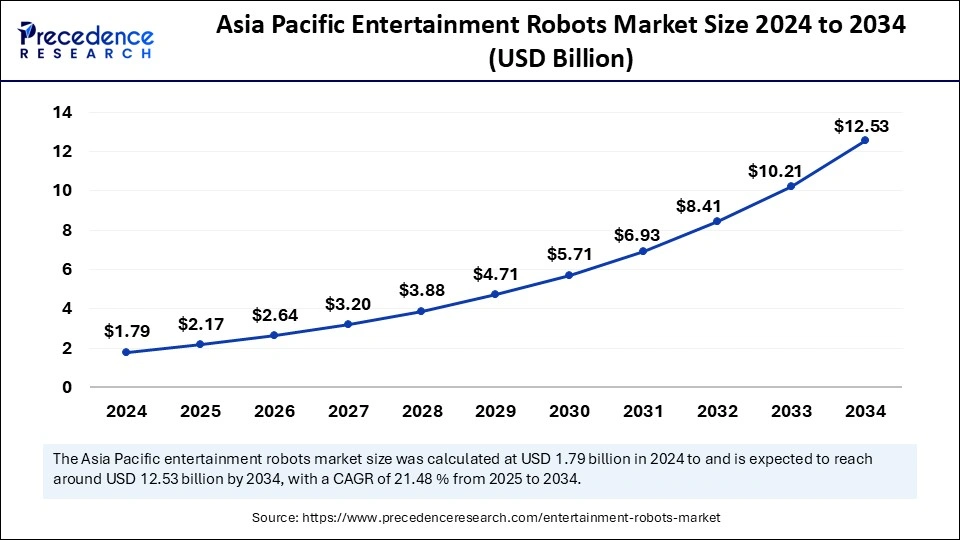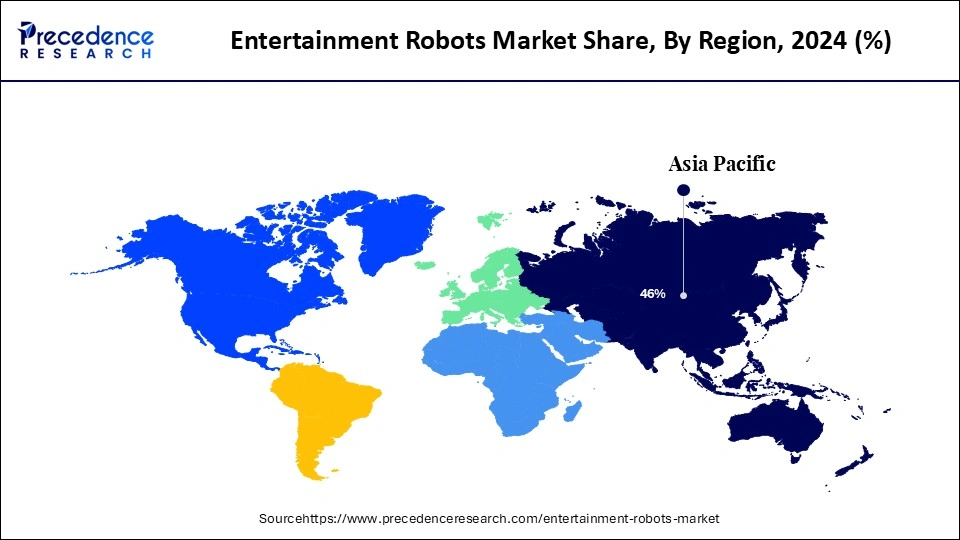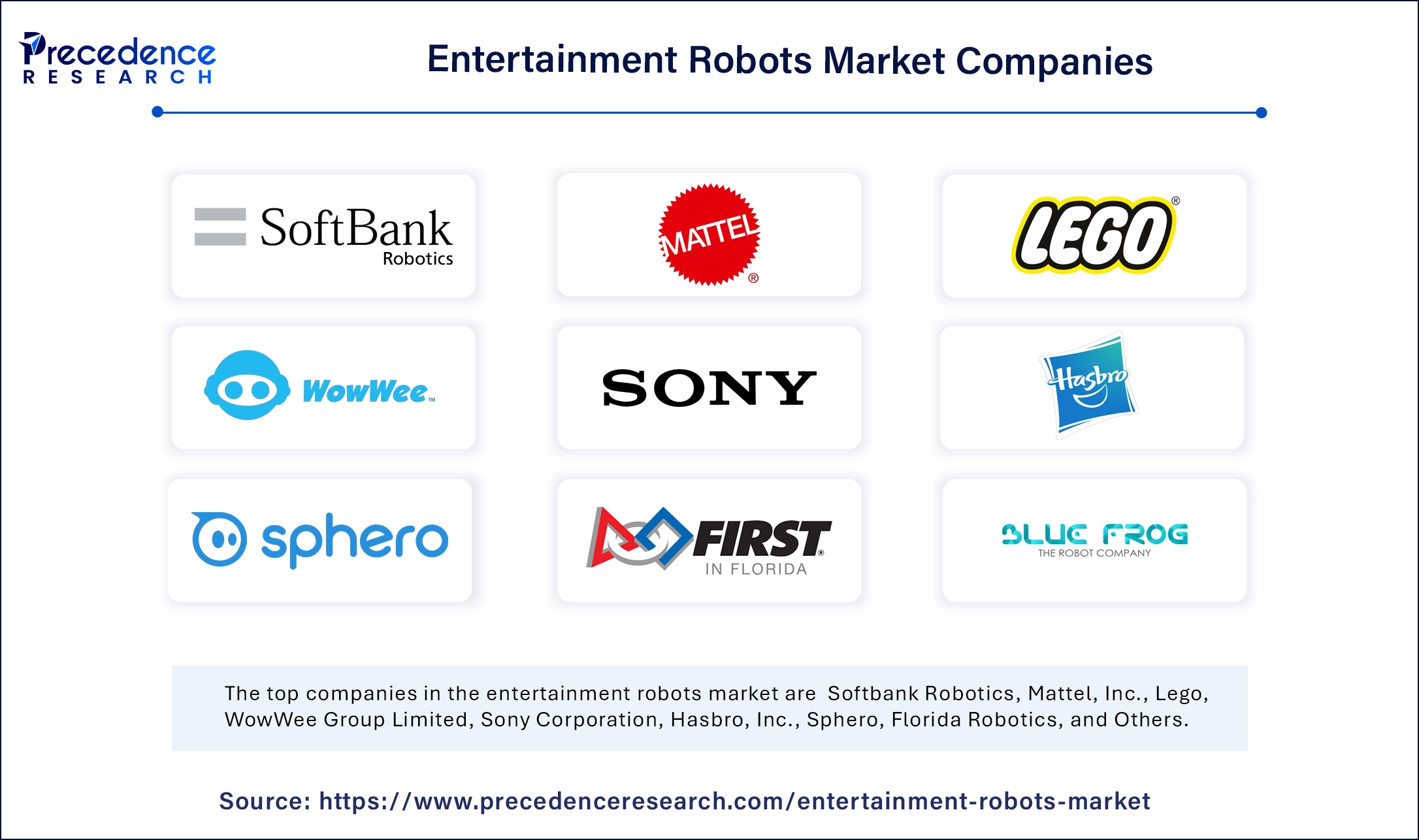August 2024
The global entertainment robots market size is calculated at USD 4.72 billion in 2025 and is forecasted to reach around USD 26.94 billion by 2034, accelerating at a CAGR of 21.35% from 2025 to 2034. The Asia Pacific market size surpassed USD 1.79 billion in 2024 and is expanding at a CAGR of 21.48% during the forecast period. The market sizing and forecasts are revenue-based (USD Million/Billion), with 2024 as the base year.
The global entertainment robots market size accounted for USD 3.89 billion in 2024 and is predicted to increase from USD 4.72 billion in 2025 to approximately USD 26.94 billion by 2034, expanding at a CAGR of 21.35% from 2025 to 2034. Factors such as rising fascination with robotics amongst consumers, technological innovations, and growing demand for interactive entertainment solutions are expected to drive the growth of the market throughout the forecast period.

In the ever-evolving landscape of technology, the integration of artificial intelligence has paved the way for a new paradigm of entertainment robots. The integration of machine learning (ML) and artificial intelligence (AI) technologies can offer a personalized, interactive, and immersive experience. AI-powered entertainment robots can effectively recognize facial expressions, voice commands, and gestures, which results in more natural interactions. By harnessing the power of AI, entertainment robots are capable of understanding musical cues, engaging with audiences, generating expressive performances, and adapting the audience’s behavior.
The Asia Pacific entertainment robots market size was evaluated at USD 1.79 billion in 2024 and is projected to be worth around USD 212.53 billion by 2034, growing at a CAGR of 2148% from 2025 to 2034.

Asia Pacific dominated the entertainment robots market with the largest share in 2024. The growth of the market in the region is driven by the strong presence of key players, high consumer demand for interactive and immersive entertaining experiences, and increased disposable income. The region is likely to sustain its position in the market during the upcoming period due to the surging use of robots among the elderly and children for educational, therapeutic, and caregiving purposes, increasing investment in technology-driven products, a supportive government framework, and increasing integration of artificial intelligence (AI) and machine learning (ML) technologies. The increasing adoption of entertainment robots in emerging markets, such as Japan, China, and South Korea, is anticipated to drive regional growth.
North America is projected to witness the fastest growth in the coming years. In North America, entertainment robots are widely deployed in live performances, theme parks, and robotics in movies. These robots are captivating people’s imaginations and bringing joy to millions. Factors such as the presence of key market players, rapid technological innovation, rising consumer demand for entertainment robots for leisure purposes, and governmental support for the development of innovative robots further support market growth. The popularity of humanoid robots is also increasing in the region. These robots can perform various tasks, such as singing, dancing, and playing musical instruments, providing a unique, personalized, and immersive entertainment experience. With increasing disposable incomes, people in the region are increasingly seeking out high-tech toys, immersive experiences, and cutting-edge robots that deliver an outstanding entertainment experience.

Europe is anticipated to grow at a notable rate. The growth of the entertainment robots market in Europe can be attributed to the increasing demand for entertainment robots for leisure purposes, rising investment in humanoid robots, increasing disposable income, increasing popularity of augmented reality (AR) and virtual reality (VR) technologies, and rising applications of entertainment robots in educational institutions like STEM learning. In the healthcare industry, entertainment robots are being widely used for engagement and therapeutic assistance. These robots are equipped with sophisticated features like cognitive computing, robot vision, and voice recognition, delivering patients a more personalized and interactive experience.
Robots are rapidly revolutionizing the entertainment industry, from enhancing live performances to creating immersive experiences. Entertainment robots are designed to amuse and entertain humans. Entertainment robots can perform various tasks, including dancing, singing, playing games, and others. These robots are widely adopted in various entertainment segments, including theme parks, cinemas, game centers, and private households. The entertainment robots market is expected to grow rapidly in the coming years due to the rising consumer demand for unique entertainment.
| Report Coverage | Details |
| Market Size by 2034 | USD 26.94 Billion |
| Market Size by 2025 | USD 4.72 Billion |
| Market Size by 2024 | USD 3.89 Billion |
| Market Growth Rate from 2025 to 2034 | CAGR of 21.35% |
| Dominated Region | Asia Pacific |
| Fastest Growing Market | North America |
| Base Year | 2024 |
| Forecast Period | 2025 to 2034 |
| Segments Covered | Product, End-User, and Regions |
| Regions Covered | North America, Europe, Asia-Pacific, Latin America and Middle East & Africa |
Increasing Deployment of Entertainment Robots in Theme Parks
The rising deployment of entertainment robots in theme parks is anticipated to boost the growth of the entertainment robots market during the forecast period. Embracing entertainment robots in amusement parks, theme parks, and entertainment venues can create unforgettable memories for children and adults. From outstanding performers to engaging greeters and knowledgeable guides, entertainment robots give a remarkable touch of wonder and excitement to visitor’s experience. These robots are specifically designed to provide visitors with enjoyment, amusement, and entertainment in several interactive activities, such as singing, dancing, and playing musical instruments. Such factors are fuelling the market’s growth significantly.
Technical Complexity in Integration
Technical complexities that occurred during the integration of entertainment robots hamper the market's growth. Some robots may have limited functionality or fail to meet consumer expectations. In addition, the high cost of these robots may slow their adoption in amusement and theme parks due to budget constraints, particularly in middle- and lower-income countries.
Growing Consumer Demand for Personalized Experience
The growing consumer demand for personalized experience is projected to offer lucrative opportunities in the entertainment robots market. Entertainment robots are continuously evolving through ongoing technological advancement, creating more unique, personalized, and immersive entertainment experiences among people of all ages. From enthralling toys to lovable companions and stunning entertainers, these entertainment robots are increasingly gaining popularity and sparking imaginations. The adoption of these robots provides a glimpse into a world where technology and magic merge effortlessly to create unforgettable experiences for users. Therefore, as robots continue to evolve and become more sophisticated, robots hold the potential to shape the future of entertainment.
The robot toys segment held the largest share of the entertainment robots market in 2024. Robot toys are mechanical or electronic toys that represent a combination of fun and technology. These toys can move, make sounds, and are capable of performing various actions, such as walking, dancing, and interacting with people. With rapid technological innovation, these toys have transformed from basic remote-controlled devices to AI-driven, offering interactive and immersive entertaining experiences. Moreover, rising parents' desire for intellectually stimulating play for their children is expected to accelerate the adoption of robot toys during the forecast period.
On the other hand, the educational robots segment is expected to witness remarkable growth during the forecast period. There is an increasing adoption of educational robots to bridge the gap between theoretical knowledge and practical application. Over the years, the educational industry landscape has undergone a remarkable transformation, with a rising focus on interactive and experiential learning. Educational robots can improve learning and enhance problem-solving skills. Several educational institutions are increasingly adopting these robots to promote Science, Technology, Engineering, and Mathematics (STEM) fields and also make coding and robotics approachable for students.
The retail segment led the entertainment robots market with the largest share in 2024. In the retail industry, entertainment robots can enhance the shopping experience, promote products in unique ways, and provide interactive services to the customer. The adoption of these robots can lead to increased sales and positive brand perception. Their visual appeal can spark interest in robotics and technology among the general public.
On the other hand, the educational segment is expected to grow significantly during the forecast period. The growth of this segment can be attributed to the increasing adoption of entertainment robots in educational institutions to provide students with a fun and interactive experience. These robots enable students to gain knowledge regarding programming and robotics, as well as improve their critical thinking and innovative problem-solving skills.

By Product
By End-User
By Region
For inquiries regarding discounts, bulk purchases, or customization requests, please contact us at sales@precedenceresearch.com
No cookie-cutter, only authentic analysis – take the 1st step to become a Precedence Research client
August 2024
October 2024
January 2025
October 2024